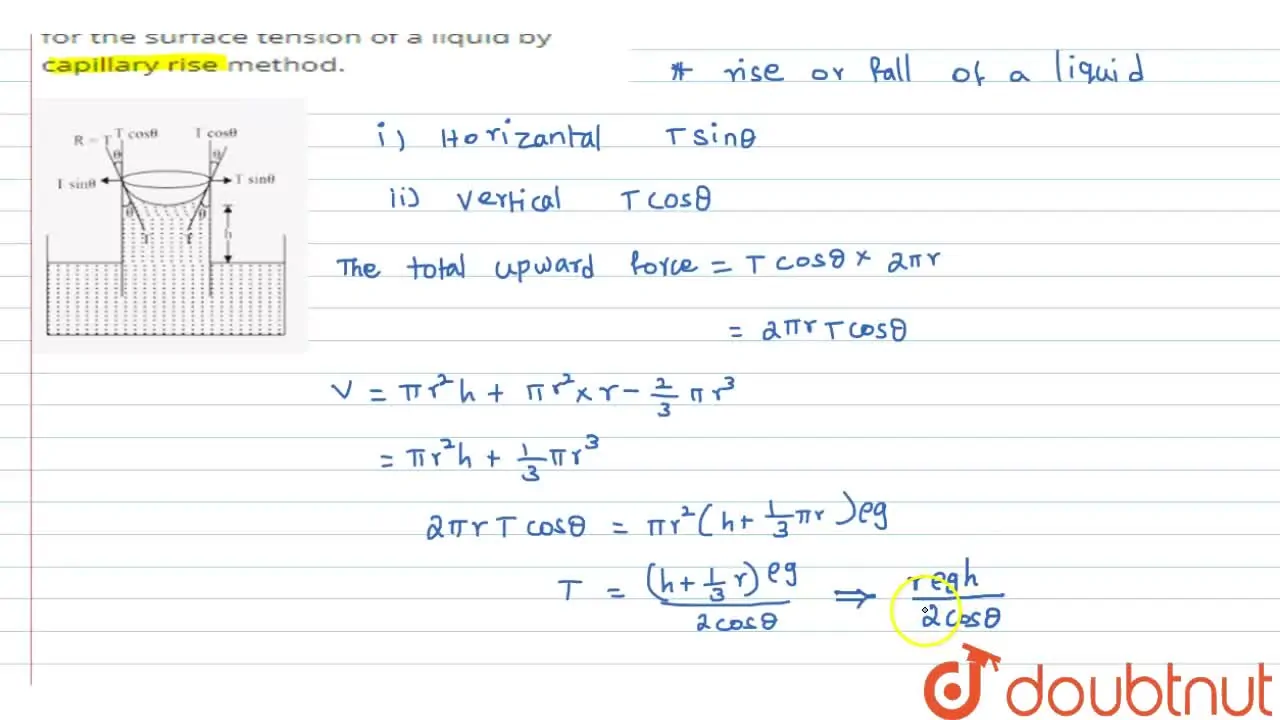What is capillarity? Obtain an expression for the surface tension of a liquid by capillary rise method.Solution in Tamil
In a liquid whose angle of contact which solid is less than 90 degree, suffers capillary rise. On other hand, in a liquid whose angle of contact is greater than 90 degree suffers capillary fall. The rise or fall of a liquid in a narrow tube is called capillarity for capillary action.

Practical application of capillarity
(i) due to capillary action, oil rises in the cotton within an earthen lamp. Likewise, sap raises from the roots of a plant to its leaves and branches.
(ii) absorption of ink by a blotter paper.
(iii) capillary action is also essential for the tear fluid from the eye to drain constantly.
(iv) cotton dresses are preferred in summer because cotton dresses have find force which acts as capillaries for sweat.
Surface Tension by capillary rise method: the pressure difference across a curved liquid-air interface is is the basic factor behind the rise up of water in a narrow tube (influence of gravity is ignored). The capillary rise is more dominant in the case of of very fine tubes. But the phenomenon is the outcome of the force of surface tension. In order to arrive a relation between the capillary rise (h) and surface tension (T), consider a capillary to which is held vertically in a beaker containing water, the water rises in the capillary tube to a height h due to surface tension.
the surface tension force FT, acts along the tangent at the point of contact downwards and its reaction for upwards. Surface tension t, it.s resolved into components (i) horizontal component Tsinθ and (ii) vertically componentTcosθ acting awards, all along the whole circumstances of meniscus.
Where θ is the angle of contact, r is the radius of the tube. Let ρ be the density of water and h be the height to which the liquid rises inside the tube. Then ,
(The volume of liquidcolumn in the tube, V)=(Volume of the liquidcolumn of radius r height h)+(Volume of liquid of radius r and height h-volume of the hemisphere of radius r)
V=πr2h+(πr2×r−23πr3)
⇒V=πr2h+13πr3
The upwards force supports the weight of the liquid column above the free surface, therefore,
2πrTcosθ=πr2(h+13r)ρg⇒T=r(h+13r)ρg2cosθ
If the capillary is a very fine tube of radius (i.e, radius is very small) then r3 can be neglected when it is compared to the height h. therefore,
T=rρgh2cosθ
Liquid rises through a height h
h=2Tcosθrρg⇒h∝1r. This implies that the capillary rise (h) is inversely, proportional to the radius (r ) of the tube i.e, the smaller the radus of the tube greater will be the capillarity.
Related Playlists
- BOOK - FULL MARKSCHAPTER - PROPERTIES OF MATTEREXERCISE - Textual Evaluation Solved - Numerical Problems5videos
PROPERTIES OF MATTER
- BOOK - FULL MARKSCHAPTER - PROPERTIES OF MATTEREXERCISE - Textual Evaluation Solved - Conceptual Questions5videos
PROPERTIES OF MATTER
- BOOK - FULL MARKSCHAPTER - PROPERTIES OF MATTEREXERCISE - Textual Evaluation Solved - Short Answer Questions29videos
PROPERTIES OF MATTER
- BOOK - FULL MARKSCHAPTER - OSCILLATIONS EXERCISE - ADDITIONAL QUESTIONS SOLVED (IV NUMERICAL PROBLEMS )10videos
OSCILLATIONS
- BOOK - FULL MARKSCHAPTER - SAMPLE PAPER - 2EXERCISE - PART-IV10videos
SAMPLE PAPER - 2
Similar Questions
A cappilary of diameter d mm is dipped in water such that the water rises to a height of 30 mm. If the radius of the capillary is made (23) of its previous value, then compute the height up to which water will rise in the new capillary ?
01:45View SolutionWhy coffee runs up into a sugar lump (a small cube of sugar) when one corner of the sugar lump is held in the liquid?
02:24View SolutionDefine stress and strain.
01:57View SolutionA pendulum is hung from the roof of a sufficiently high building and is moving freely to and fro like a simple harmonic oscillator. The acceleration of the bob of the pendulum is 20ms−2 at a distance of 5 m from the mean position. To find the time period of oscillation.
02:12View SolutionExplain in detail the idea of weightlessness using lift as an example.
04:48View SolutionIt is said that a liquid rises or is depressed in a capillary due to the surface tension. If a liquid neither rises nor depresses in a capillary, can we conclude that the surface tension of the liquid is zero ?
10:27View SolutionBy the method of dimensions, obtain an expression for the surface tension S of a liquidk rising in a capillary tube. Assume that S depends on mass m of liquied, Pressure p of liquid and radius r of the capillary tube. Take K=1/2.
02:07View SolutionIf a liquid used in capillary rise method for measuring surface tension whose surface tension is more than that of water, then rise in capillary tube
10:27View SolutionThe rise of a liquid in a capillary tube depends on
07:32View SolutionObtain an expression for the rise of a liquid in a capillary tube.
08:57View SolutionWhat is capillarity? Obtain an expression for the surface tension of a liquid by capillary rise method.
10:27View SolutionGive the expression for surface tension of a liquid in a capillary tube.
10:27View SolutionWhat is capillarity? Obtain an expression for the surface tension of a liquid by capillary rise method.
02:26View SolutionDefine Capillarity and angle of contact. Derive an expression for the ascent of a liquid in a capillary tube.
02:28View SolutionWhat do you mean by capillarity? Give some daily life examples of capillarity. Also derive an expression for rise of liquid in a capillary tube.
03:22View Solution


